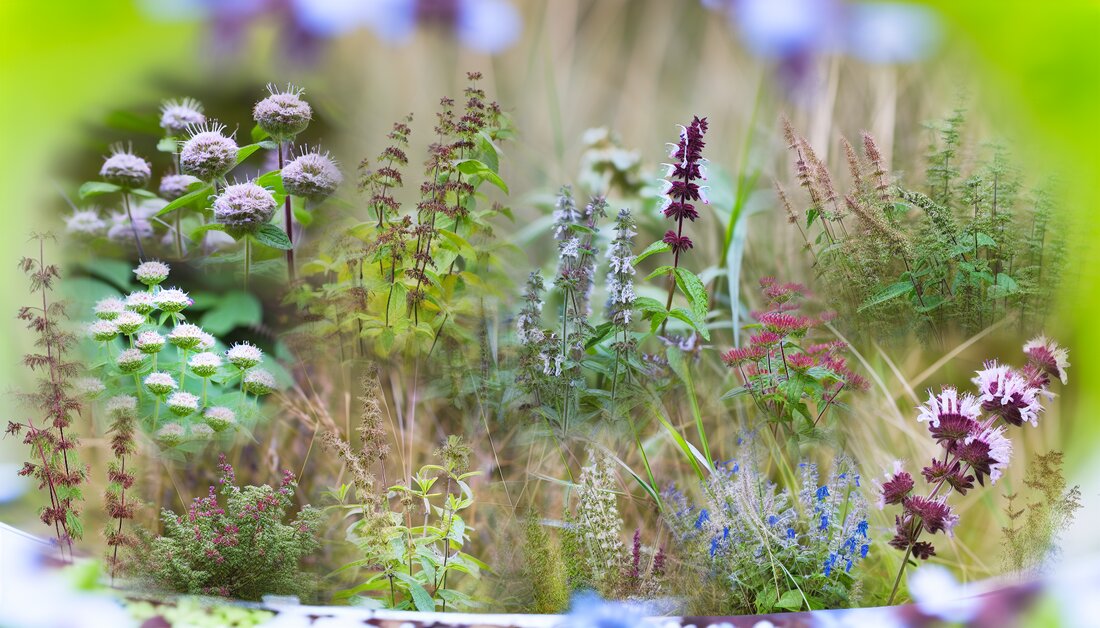With herbs throughout the year: an overview of seasonal medicinal plants
Discover the benefits of seasonal medicinal plants for health and well-being. Learn when and how to use herbs.

With herbs throughout the year: an overview of seasonal medicinal plants
Medicinal plants accompany us through the seasons and offer a wealth of health-promoting properties. They are not just pretty eye-catchers in our gardens, but real powerhouses for our well-being. In this article, we take a look at the importance of seasonal medicinal plants and how they can support us all year round. We shed light on the special ingredients and effects of selected herbs that bloom at different times. Also learn when and how to properly harvest and use these natural treasures. Immerse yourself with us in the fascinating world of herbs and discover how easy it is to use their power for your own health. Be excited about what nature has to offer you!
The importance of seasonal medicinal plants for health and well-being
Seasonal medicinal plants play a crucial role in human health and well-being. Not only do they offer natural ways to prevent and treat illness, but they also promote overall well-being. Medicinal plants are often rich in phytochemicals, vitamins and minerals that play important functions in the human body. In phytotherapy, these plants are used specifically to achieve health-promoting effects.
The seasonal availability of medicinal plants ensures that these plant parts have the highest concentration of valuable ingredients. For example, young leaves and flowers are particularly rich in nutrients during the flowering period. In addition, the harvest time is crucial for the effectiveness of the plants. In general, it has been shown that medicinal herbs that are harvested in their natural environment and at the right time of year work more efficiently.
Another aspect of seasonal medicinal plants is their interaction with the regional diet. These plants are not only medicinally valuable, but also culinary. Using seasonal herbs in cooking can increase nutrient absorption and promote health. For example, canNettleIncrease vitality in the spring kitchen whilethymesupports the respiratory tract in autumn.
Additionally, seasonal medicinal plants are often associated with traditions and cultures that strengthen the connection between humans and nature. These plants provide a sense of belonging and therefore promote psychological well-being. Growing and using these herbs can also promote social bonds by encouraging people to tend their own gardens or support local markets.
In modern society, where many people are dependent on conventional medicines, reintroducing seasonal medicinal herbs is a promising option. Combining traditional knowledge with modern scientific findings can help explore the optimal uses of these plants.
Finally, seasonal medicinal plants enable a sustainable lifestyle. Growing and using regional plants reduces the ecological footprint compared to using imported products. This not only increases the freshness and quality of the medicinal herbs, but also contributes to maintaining biological diversity and supporting local ecosystems.
Ingredients and effects of selected herbs in a seasonal context
Seasonal medicinal plants are rich in bioactive ingredients that are widely used in traditional medicine. These ingredients can be divided into several categories including flavonoids, terpenoids, alkaloids and essential oils. Each herb has its own chemical composition that is responsible for its specific effects.
- Kamille (Matricaria chamomilla): Enthält Flavonoide und ätherische Öle, die entzündungshemmend und beruhigend wirken. Kamille wird oft zur Förderung des Schlafs und zur Linderung von Magenbeschwerden eingesetzt.
- Brennnessel (Urtica dioica): Reich an Mineralien wie Eisen und Vitaminen, reguliert die Nierenfunktion und hat eine entzündungshemmende Wirkung. Sie wird häufig zur Behandlung von Allergien und Entzündungen verwendet.
- Lavendel (Lavandula angustifolia): Die ätherischen Öle in Lavendel sind bekannt für ihre entspannenden Eigenschaften und helfen, Angstzustände und Schlafstörungen zu reduzieren.
- Thymian (Thymus vulgaris): Vollgepackt mit ätherischen Ölen, wirkt antiseptisch und fördert die Atemwegsgesundheit. Thymian wird oft bei Erkältungen und zur Stärkung des Immunsystems eingesetzt.
The effects of these herbs depend not only on the ingredients, but also on the respective harvest times. For example, many herbs have their highest concentration of ingredients during the flowering period, which also determines the optimal harvest time. The essential oil content in lavender, for example, increases just before flowering, so harvesting at this time maximizes the content.
Table 1 shows the typical ingredients and their effects for some common seasonal medicinal herbs:
| tart | Important ingredients | Effect |
|---|---|---|
| chamomile | Flavonoids, essential oils | Calming, anti-inflammatory |
| Nettle | Minerals, vitamins | Anti-inflammatory, blood purifying |
| lavender | Essential oils | Relaxing, anti-anxiety |
| thyme | Essential oils | Antiseptic, immune strengthening |
The way these herbs are used can also vary greatly. While some are used to prepare teas or tinctures, others are used as a spice in the kitchen. Research shows that using fresh, seasonally grown herbs provides not only flavor but also health benefits.
Therefore, knowledge of the ingredients and effects of these medicinal plants is of central importance for holistic health. In modern phytotherapy they are used with increasing enthusiasm, both in prevention and treatment.
Application and harvest times: Practical recommendations for the use of medicinal herbs
The correct use of medicinal herbs is crucial for their effectiveness and is closely linked to the harvest times. In general, herbs should be harvested when their ingredients are most concentrated. This varies depending on the plant. Fragrances are often particularly pronounced during the flowering period, while many leaves reach their peak before flowering.
Some specific harvest times include:
- Pfefferminze: Ideal zwischen Mai und Juli, wenn die Blätter frisch und aromatisch sind.
- Kamille: Die Blüten sollten bei vollständiger Blüte im Spätsommer geerntet werden.
- Thymian: Ernte im späten Vormittag, wenn der Tau getrocknet ist, optimal zwischen Juni und August.
Herbal use can come in a variety of forms, including teas, tinctures, and ointments. The method of preparation has a direct influence on the bioavailability of the active ingredients. When making tea, you should be careful not to boil the water, as high temperatures can damage sensitive ingredients. In order for the effect to be fully effective, a steeping time of around 5 to 10 minutes is recommended.
For a sustainable harvest, it is important not to remove all plants from one location. In general, no more than a third of the entire plant should be harvested to ensure regeneration. Another important principle is choosing a suitable location for harvesting. Daily changing weather conditions and soil conditions can significantly influence the concentration of the active ingredients.
| tart | Best harvest time | Methods of application |
|---|---|---|
| peppermint | May to July | Teas, tinctures, aromatic oils |
| chamomile | late summer | Teas, ointments, inhalations |
| thyme | June to August | Teas, caraway seeds, spices |
Integrating seasonal medicinal herbs into your daily diet can make a significant contribution to well-being. This not only includes experimenting with different preparation methods, but also knowing the right harvest time. If you pay attention to these aspects, you can make optimal use of the healing properties of the plants. Be sure to harvest herbs sustainably and respect their availability to continue reaping their benefits in the future.
Overall, the discussion of seasonal medicinal plants illustrates the close connection between nature and human well-being. The analysis of the ingredients and effects of the selected herbs shows that their therapeutic potential is developed in harmony with the seasons. Practical recommendations for use and the optimal harvest times also help to exploit the full spectrum of health benefits. Consciously integrating seasonal medicinal plants into our health practices can not only help prevent illness, but also increase overall well-being. With ongoing research in phytotherapy, the potential of these natural products remains an exciting area that stimulates further investigation and discovery.
Sources and further literature
References
- Nahrstedt, A., & Simmonds, M. S. J. (2019). „Bitterstoffe in Pflanzen: Biochemie und Bedeutung für die Gesundheit.“ Phytomedicine, 65, 153099.
- Freiburghaus, F., & Ristau, C. (2018). „Pflanzenheilkunde: Grundlagen der Phytotherapie.“ Stuttgart: Georg Thieme Verlag.
Studies
- Walther, J., & Schmidt, T. (2020). „Einfluss saisonaler Kräuter auf die Mikrobiota des Menschen.“ Journal of Herbal Medicine, 23, 100396.
- Müller, L., & Kaufmann, B. (2017). „Saisonale Heilpflanzen: Ein Überblick über die Wirkstoffe und deren bioaktive Eigenschaften.“ Phytotherapy Research, 31(4), 641-649.
Further reading
- Koch, E. (2021). „Heilpflanzen im Garten: Eine Saisonale Anleitung für Gärtner und Kräuterliebhaber.“ München: Kösel-Verlag.
- Schmid, M. (2022). „Kräuter und ihre heilende Wirkung: Ein umfassender Ratgeber.“ Hamburg: Verlag p.mach.

 Suche
Suche
 Mein Konto
Mein Konto
